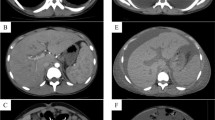Abstract
Interleukin-11 (Oprelvekin, Neumega) is a newly introduced thrombopoietic growth factor that stimulates production, differentiation, and maturation of megakaryocytes and platelets. Reversible periostitis has been reported as the side effect of the drug in primates and in the phase I/II trials. We report our experience with 5 cases of periostitis, occurring in thrombocytopenic children with three non-malignant and two malignant conditions, out of 24 pediatric patients treated with IL-11 at 75 µg/kg per day for a median of 17 days. The findings were noted in the clavicle or the proximal humerus. Two patients also had forearm and lower-extremity long-bone involvement. All patients had normal bones before IL-11 was given, changes occurred in both non-malignant and malignant diseases, and periostitis disappeared after use of the drug was discontinued. The distribution and appearance of the changes are similar to prostaglandin E1 and hypervitaminosis A. The changes are reversible after termination of treatment and are most noted in younger patients. The exact mechanism is not clear. The detection of periostitis makes it essential for the radiologists to enquire as to what medications patients are receiving. The pediatric doses (75 μg/kg/d) are above those recommended for adult patients (50 μg/kg/d) and this may account for the pediatric bone changes of periostitis.



Similar content being viewed by others
References
Kirov I, Goldman S, Blazar B, et al (1997) Recombinant human interleukin 11 (Neumega) is tolerated as double the adult dose and enhances hematopoietic recovery following ifosfamide, carboplatin, and etoposide (ICE) chemotherapy in children. Blood 90:581a
Bracho F, Krailo M, Blazar B, et al (1999) Clinical and hematological recovery in children with recurrent/refractory solid tumors treated with ifosfamide, carboplatin, and etoposide (ICE) followed by sequential trials of IL-11/G-CSF, IL-6/G-CSF, PIXY321, or G-CSF. Proc Am Soc Clin Oncol 18:47a
Bracho F, Davenport V, Goldman S, et al (2000) Results of a phase I/II trial of Interleukin-11 in combination with G-CSF in children with solid tumors following ifosfamide, carboplatin, etopside (ICE). Proc Am Soc Clin Oncol 19:207a (updated data will be presented at ASCO 2003)
Wyeth-Ayerst Pharmaceuticals (2001) Manufacturer's communication
Author information
Authors and Affiliations
Corresponding author
Rights and permissions
About this article
Cite this article
Milman, E., Berdon, W.E., Garvin, J.H. et al. Periostitis secondary to interleukin-11 (Oprelvekin, Neumega). Pediatr Radiol 33, 450–452 (2003). https://doi.org/10.1007/s00247-003-0893-x
Received:
Accepted:
Published:
Issue Date:
DOI: https://doi.org/10.1007/s00247-003-0893-x




